Strategic Environment Analysis of Sainsbury’s: A Consultant’s Report
VerifiedAdded on 2023/06/11
|14
|3905
|472
Report
AI Summary
This report provides a strategic analysis of Sainsbury’s, a major retail organization in the United Kingdom, by examining its internal and external environments. The external environment is assessed using the PESTLE framework, covering political, economic, social, technological, legal, and environmental factors influencing Sainsbury’s operations. The internal environment is evaluated through a SWOT analysis, identifying the company's strengths, weaknesses, opportunities, and threats. Additionally, the report analyzes the competitive forces within the retail industry using Porter’s Five Forces framework, focusing on the power of suppliers and buyers, the threat of substitutes, and competitive rivalry. The report also discusses Sainsbury's competitive advantages and concludes with insights into the company's strategic position. Desklib offers a wealth of similar reports and solved assignments for students seeking academic assistance.
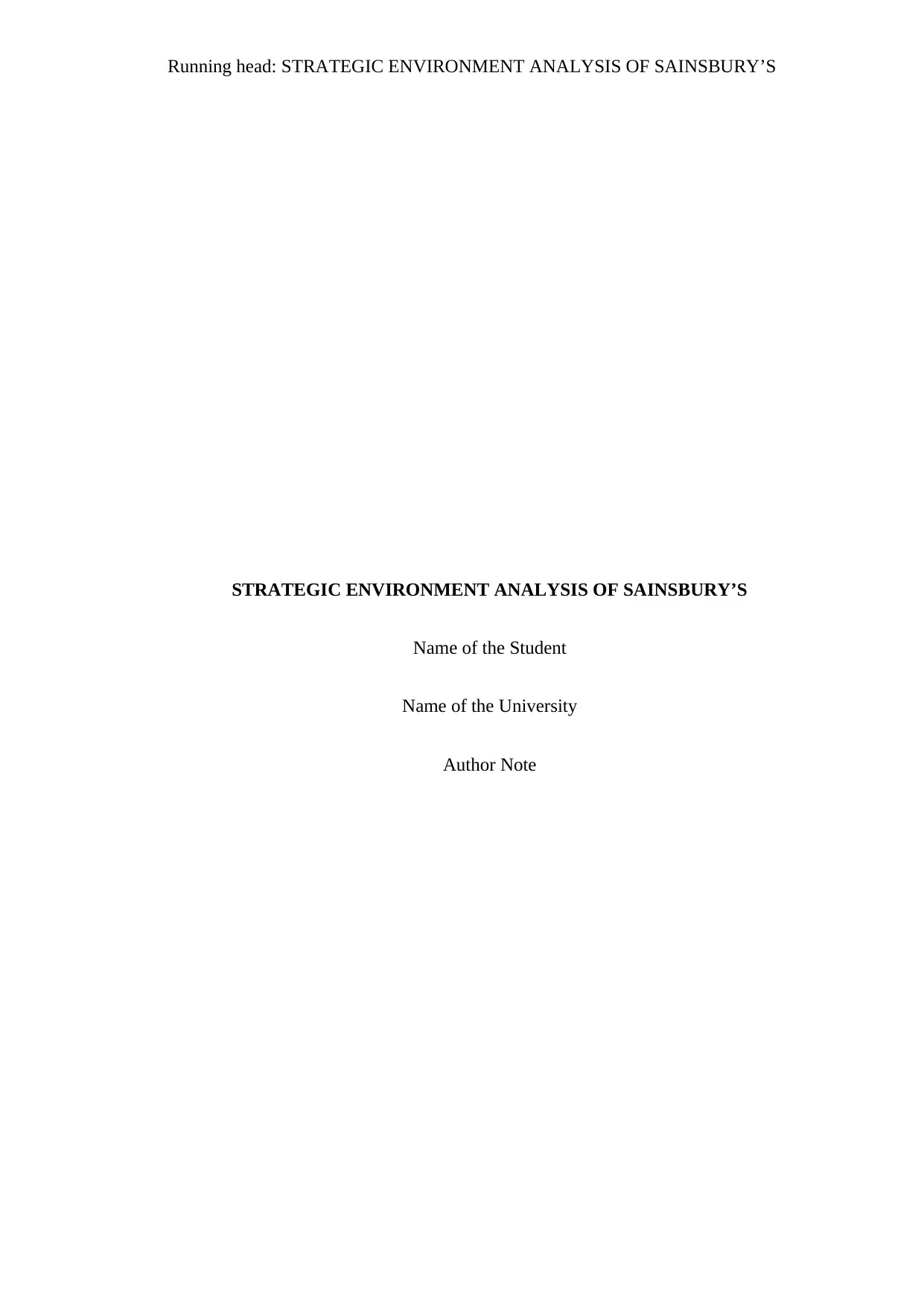
Running head: STRATEGIC ENVIRONMENT ANALYSIS OF SAINSBURY’S
STRATEGIC ENVIRONMENT ANALYSIS OF SAINSBURY’S
Name of the Student
Name of the University
Author Note
STRATEGIC ENVIRONMENT ANALYSIS OF SAINSBURY’S
Name of the Student
Name of the University
Author Note
Paraphrase This Document
Need a fresh take? Get an instant paraphrase of this document with our AI Paraphraser
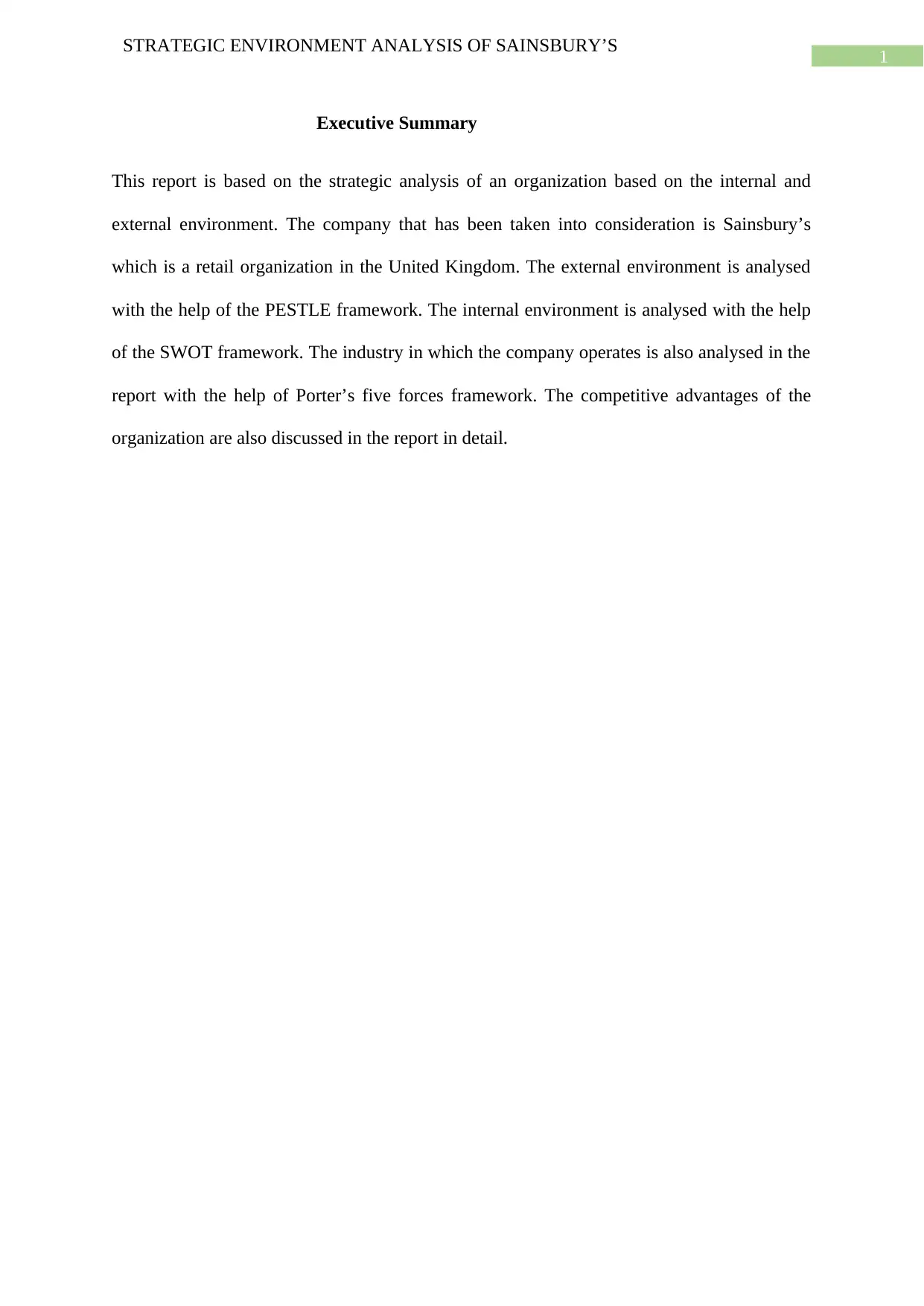
1
STRATEGIC ENVIRONMENT ANALYSIS OF SAINSBURY’S
Executive Summary
This report is based on the strategic analysis of an organization based on the internal and
external environment. The company that has been taken into consideration is Sainsbury’s
which is a retail organization in the United Kingdom. The external environment is analysed
with the help of the PESTLE framework. The internal environment is analysed with the help
of the SWOT framework. The industry in which the company operates is also analysed in the
report with the help of Porter’s five forces framework. The competitive advantages of the
organization are also discussed in the report in detail.
STRATEGIC ENVIRONMENT ANALYSIS OF SAINSBURY’S
Executive Summary
This report is based on the strategic analysis of an organization based on the internal and
external environment. The company that has been taken into consideration is Sainsbury’s
which is a retail organization in the United Kingdom. The external environment is analysed
with the help of the PESTLE framework. The internal environment is analysed with the help
of the SWOT framework. The industry in which the company operates is also analysed in the
report with the help of Porter’s five forces framework. The competitive advantages of the
organization are also discussed in the report in detail.
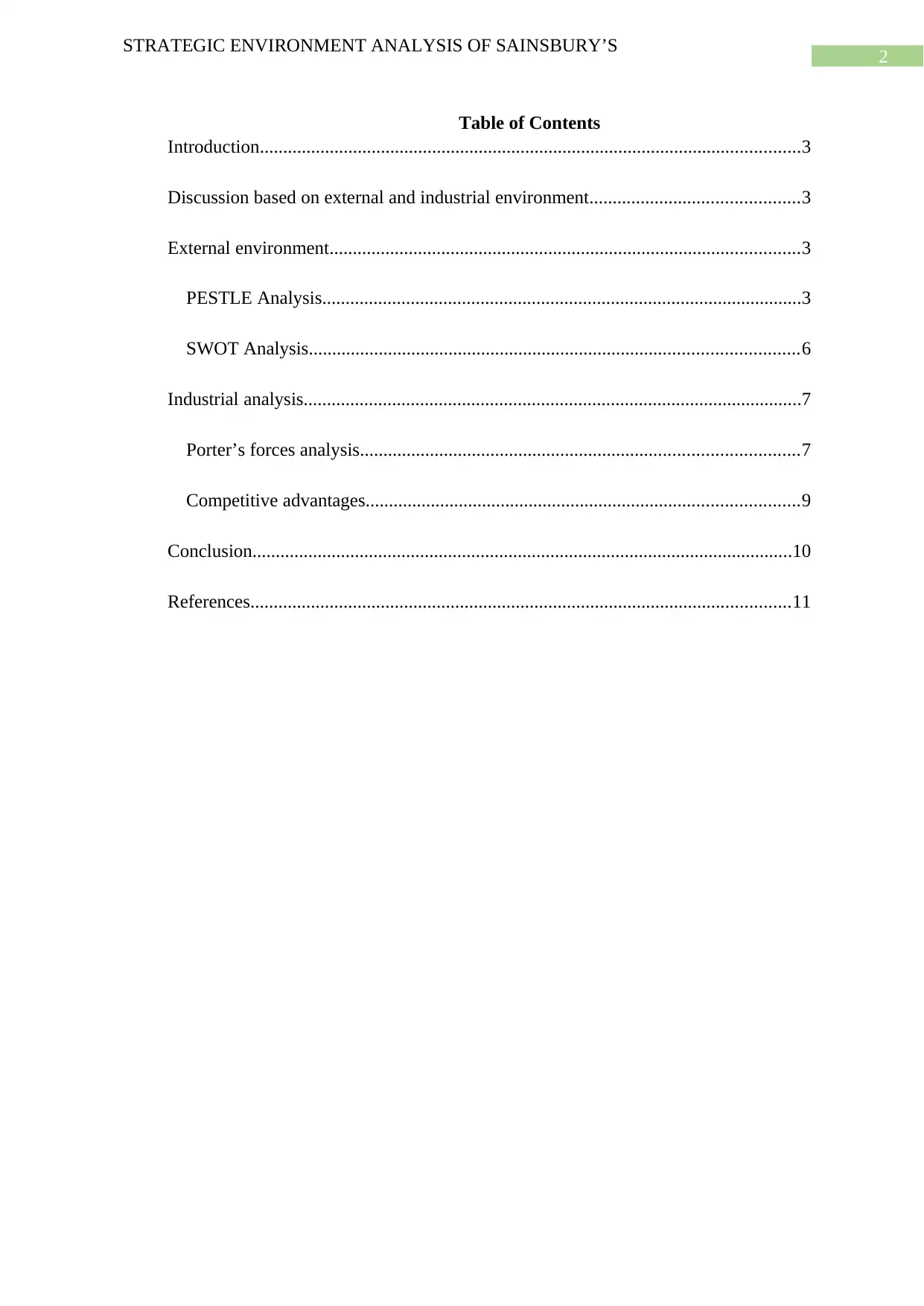
2
STRATEGIC ENVIRONMENT ANALYSIS OF SAINSBURY’S
Table of Contents
Introduction....................................................................................................................3
Discussion based on external and industrial environment.............................................3
External environment.....................................................................................................3
PESTLE Analysis.......................................................................................................3
SWOT Analysis.........................................................................................................6
Industrial analysis...........................................................................................................7
Porter’s forces analysis..............................................................................................7
Competitive advantages.............................................................................................9
Conclusion....................................................................................................................10
References....................................................................................................................11
STRATEGIC ENVIRONMENT ANALYSIS OF SAINSBURY’S
Table of Contents
Introduction....................................................................................................................3
Discussion based on external and industrial environment.............................................3
External environment.....................................................................................................3
PESTLE Analysis.......................................................................................................3
SWOT Analysis.........................................................................................................6
Industrial analysis...........................................................................................................7
Porter’s forces analysis..............................................................................................7
Competitive advantages.............................................................................................9
Conclusion....................................................................................................................10
References....................................................................................................................11
⊘ This is a preview!⊘
Do you want full access?
Subscribe today to unlock all pages.

Trusted by 1+ million students worldwide
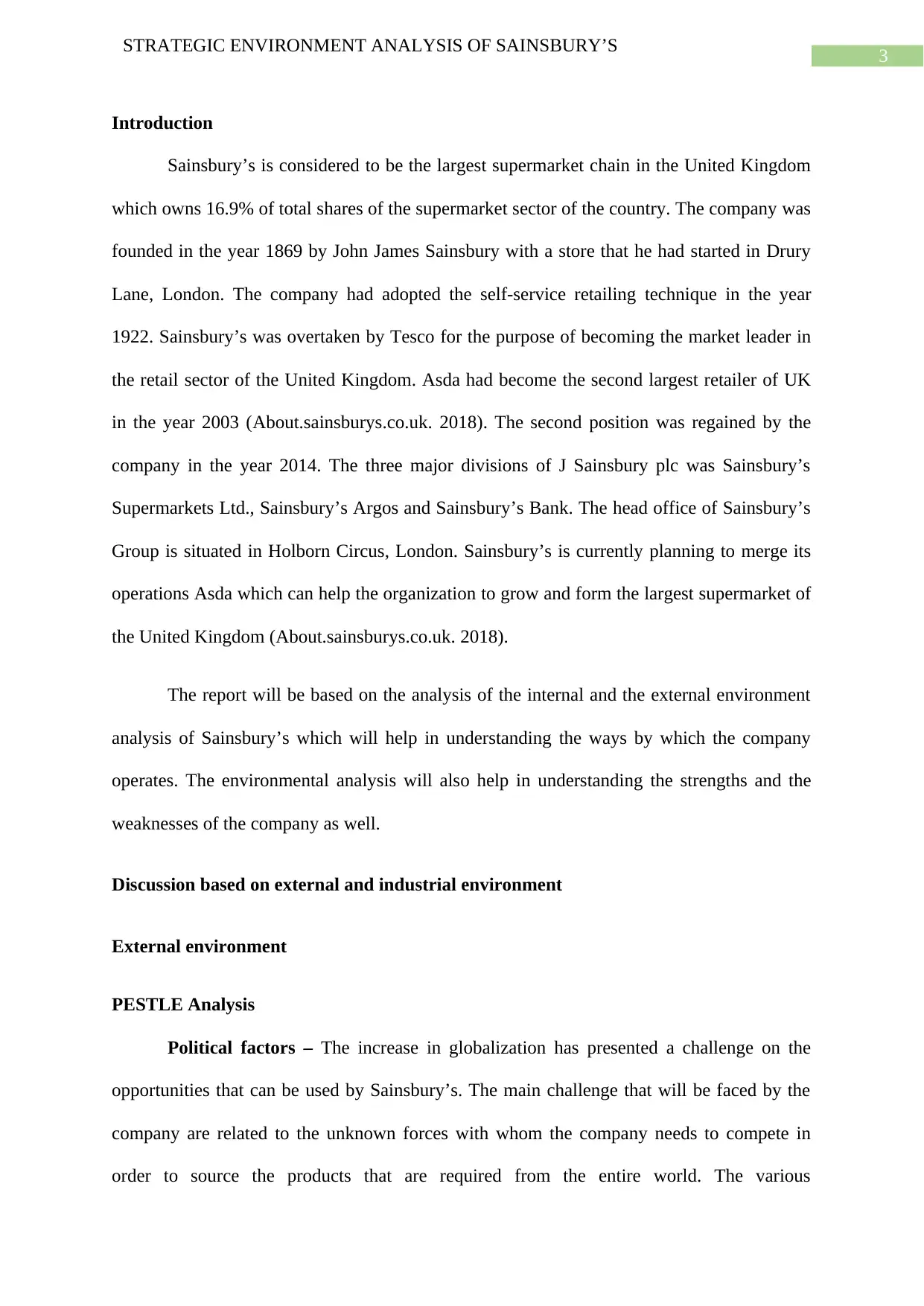
3
STRATEGIC ENVIRONMENT ANALYSIS OF SAINSBURY’S
Introduction
Sainsbury’s is considered to be the largest supermarket chain in the United Kingdom
which owns 16.9% of total shares of the supermarket sector of the country. The company was
founded in the year 1869 by John James Sainsbury with a store that he had started in Drury
Lane, London. The company had adopted the self-service retailing technique in the year
1922. Sainsbury’s was overtaken by Tesco for the purpose of becoming the market leader in
the retail sector of the United Kingdom. Asda had become the second largest retailer of UK
in the year 2003 (About.sainsburys.co.uk. 2018). The second position was regained by the
company in the year 2014. The three major divisions of J Sainsbury plc was Sainsbury’s
Supermarkets Ltd., Sainsbury’s Argos and Sainsbury’s Bank. The head office of Sainsbury’s
Group is situated in Holborn Circus, London. Sainsbury’s is currently planning to merge its
operations Asda which can help the organization to grow and form the largest supermarket of
the United Kingdom (About.sainsburys.co.uk. 2018).
The report will be based on the analysis of the internal and the external environment
analysis of Sainsbury’s which will help in understanding the ways by which the company
operates. The environmental analysis will also help in understanding the strengths and the
weaknesses of the company as well.
Discussion based on external and industrial environment
External environment
PESTLE Analysis
Political factors – The increase in globalization has presented a challenge on the
opportunities that can be used by Sainsbury’s. The main challenge that will be faced by the
company are related to the unknown forces with whom the company needs to compete in
order to source the products that are required from the entire world. The various
STRATEGIC ENVIRONMENT ANALYSIS OF SAINSBURY’S
Introduction
Sainsbury’s is considered to be the largest supermarket chain in the United Kingdom
which owns 16.9% of total shares of the supermarket sector of the country. The company was
founded in the year 1869 by John James Sainsbury with a store that he had started in Drury
Lane, London. The company had adopted the self-service retailing technique in the year
1922. Sainsbury’s was overtaken by Tesco for the purpose of becoming the market leader in
the retail sector of the United Kingdom. Asda had become the second largest retailer of UK
in the year 2003 (About.sainsburys.co.uk. 2018). The second position was regained by the
company in the year 2014. The three major divisions of J Sainsbury plc was Sainsbury’s
Supermarkets Ltd., Sainsbury’s Argos and Sainsbury’s Bank. The head office of Sainsbury’s
Group is situated in Holborn Circus, London. Sainsbury’s is currently planning to merge its
operations Asda which can help the organization to grow and form the largest supermarket of
the United Kingdom (About.sainsburys.co.uk. 2018).
The report will be based on the analysis of the internal and the external environment
analysis of Sainsbury’s which will help in understanding the ways by which the company
operates. The environmental analysis will also help in understanding the strengths and the
weaknesses of the company as well.
Discussion based on external and industrial environment
External environment
PESTLE Analysis
Political factors – The increase in globalization has presented a challenge on the
opportunities that can be used by Sainsbury’s. The main challenge that will be faced by the
company are related to the unknown forces with whom the company needs to compete in
order to source the products that are required from the entire world. The various
Paraphrase This Document
Need a fresh take? Get an instant paraphrase of this document with our AI Paraphraser
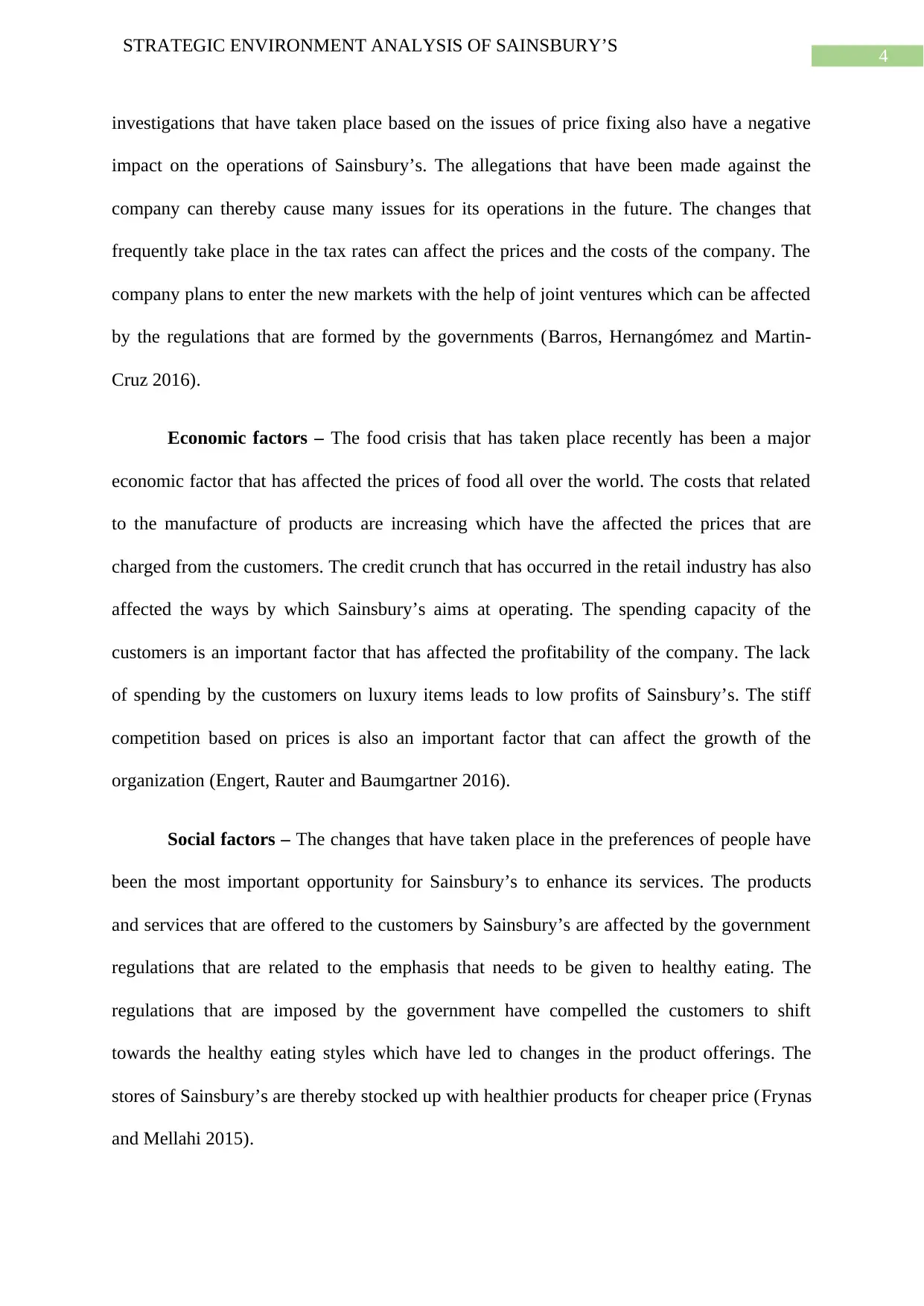
4
STRATEGIC ENVIRONMENT ANALYSIS OF SAINSBURY’S
investigations that have taken place based on the issues of price fixing also have a negative
impact on the operations of Sainsbury’s. The allegations that have been made against the
company can thereby cause many issues for its operations in the future. The changes that
frequently take place in the tax rates can affect the prices and the costs of the company. The
company plans to enter the new markets with the help of joint ventures which can be affected
by the regulations that are formed by the governments (Barros, Hernangómez and Martin-
Cruz 2016).
Economic factors – The food crisis that has taken place recently has been a major
economic factor that has affected the prices of food all over the world. The costs that related
to the manufacture of products are increasing which have the affected the prices that are
charged from the customers. The credit crunch that has occurred in the retail industry has also
affected the ways by which Sainsbury’s aims at operating. The spending capacity of the
customers is an important factor that has affected the profitability of the company. The lack
of spending by the customers on luxury items leads to low profits of Sainsbury’s. The stiff
competition based on prices is also an important factor that can affect the growth of the
organization (Engert, Rauter and Baumgartner 2016).
Social factors – The changes that have taken place in the preferences of people have
been the most important opportunity for Sainsbury’s to enhance its services. The products
and services that are offered to the customers by Sainsbury’s are affected by the government
regulations that are related to the emphasis that needs to be given to healthy eating. The
regulations that are imposed by the government have compelled the customers to shift
towards the healthy eating styles which have led to changes in the product offerings. The
stores of Sainsbury’s are thereby stocked up with healthier products for cheaper price (Frynas
and Mellahi 2015).
STRATEGIC ENVIRONMENT ANALYSIS OF SAINSBURY’S
investigations that have taken place based on the issues of price fixing also have a negative
impact on the operations of Sainsbury’s. The allegations that have been made against the
company can thereby cause many issues for its operations in the future. The changes that
frequently take place in the tax rates can affect the prices and the costs of the company. The
company plans to enter the new markets with the help of joint ventures which can be affected
by the regulations that are formed by the governments (Barros, Hernangómez and Martin-
Cruz 2016).
Economic factors – The food crisis that has taken place recently has been a major
economic factor that has affected the prices of food all over the world. The costs that related
to the manufacture of products are increasing which have the affected the prices that are
charged from the customers. The credit crunch that has occurred in the retail industry has also
affected the ways by which Sainsbury’s aims at operating. The spending capacity of the
customers is an important factor that has affected the profitability of the company. The lack
of spending by the customers on luxury items leads to low profits of Sainsbury’s. The stiff
competition based on prices is also an important factor that can affect the growth of the
organization (Engert, Rauter and Baumgartner 2016).
Social factors – The changes that have taken place in the preferences of people have
been the most important opportunity for Sainsbury’s to enhance its services. The products
and services that are offered to the customers by Sainsbury’s are affected by the government
regulations that are related to the emphasis that needs to be given to healthy eating. The
regulations that are imposed by the government have compelled the customers to shift
towards the healthy eating styles which have led to changes in the product offerings. The
stores of Sainsbury’s are thereby stocked up with healthier products for cheaper price (Frynas
and Mellahi 2015).
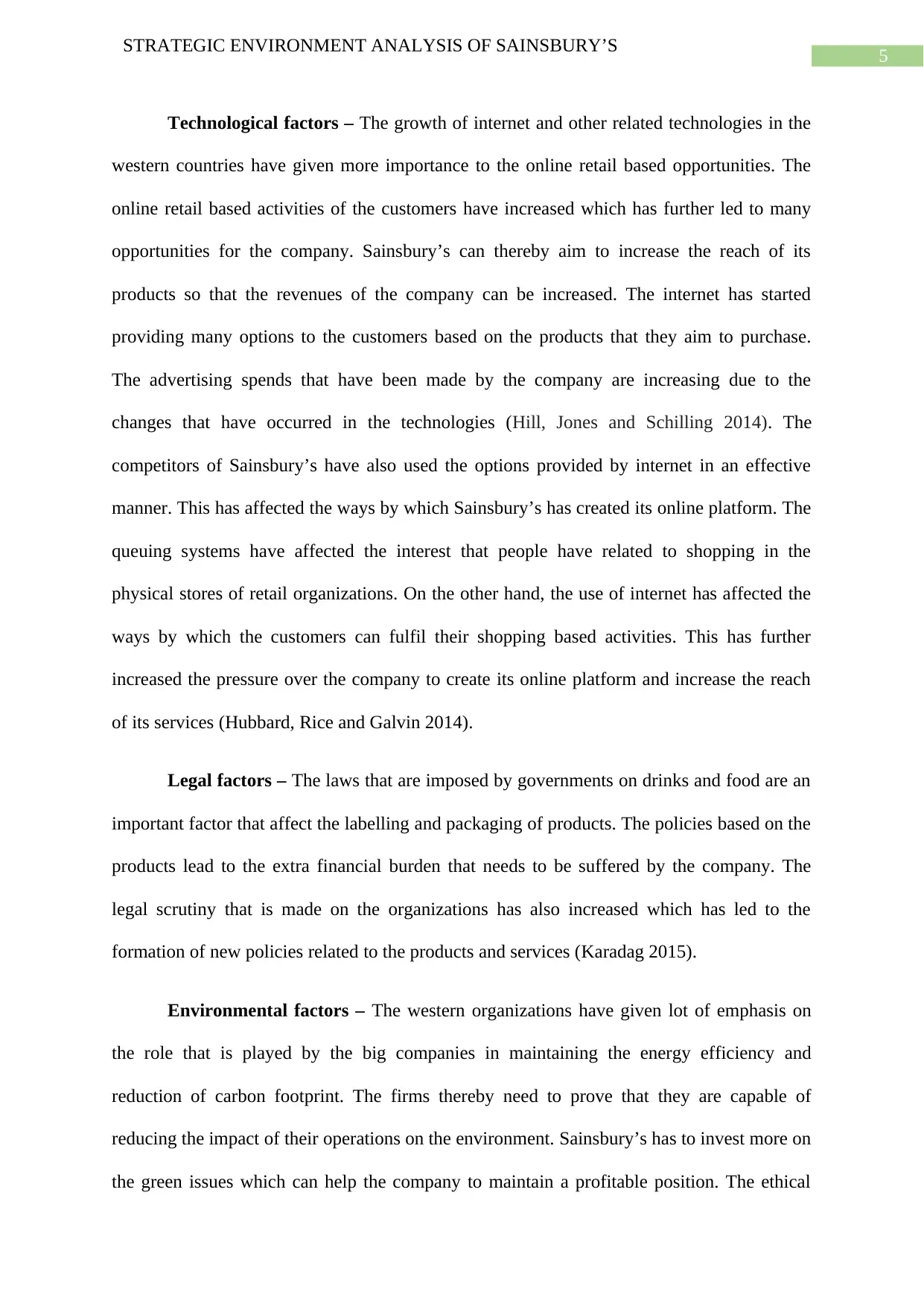
5
STRATEGIC ENVIRONMENT ANALYSIS OF SAINSBURY’S
Technological factors – The growth of internet and other related technologies in the
western countries have given more importance to the online retail based opportunities. The
online retail based activities of the customers have increased which has further led to many
opportunities for the company. Sainsbury’s can thereby aim to increase the reach of its
products so that the revenues of the company can be increased. The internet has started
providing many options to the customers based on the products that they aim to purchase.
The advertising spends that have been made by the company are increasing due to the
changes that have occurred in the technologies (Hill, Jones and Schilling 2014). The
competitors of Sainsbury’s have also used the options provided by internet in an effective
manner. This has affected the ways by which Sainsbury’s has created its online platform. The
queuing systems have affected the interest that people have related to shopping in the
physical stores of retail organizations. On the other hand, the use of internet has affected the
ways by which the customers can fulfil their shopping based activities. This has further
increased the pressure over the company to create its online platform and increase the reach
of its services (Hubbard, Rice and Galvin 2014).
Legal factors – The laws that are imposed by governments on drinks and food are an
important factor that affect the labelling and packaging of products. The policies based on the
products lead to the extra financial burden that needs to be suffered by the company. The
legal scrutiny that is made on the organizations has also increased which has led to the
formation of new policies related to the products and services (Karadag 2015).
Environmental factors – The western organizations have given lot of emphasis on
the role that is played by the big companies in maintaining the energy efficiency and
reduction of carbon footprint. The firms thereby need to prove that they are capable of
reducing the impact of their operations on the environment. Sainsbury’s has to invest more on
the green issues which can help the company to maintain a profitable position. The ethical
STRATEGIC ENVIRONMENT ANALYSIS OF SAINSBURY’S
Technological factors – The growth of internet and other related technologies in the
western countries have given more importance to the online retail based opportunities. The
online retail based activities of the customers have increased which has further led to many
opportunities for the company. Sainsbury’s can thereby aim to increase the reach of its
products so that the revenues of the company can be increased. The internet has started
providing many options to the customers based on the products that they aim to purchase.
The advertising spends that have been made by the company are increasing due to the
changes that have occurred in the technologies (Hill, Jones and Schilling 2014). The
competitors of Sainsbury’s have also used the options provided by internet in an effective
manner. This has affected the ways by which Sainsbury’s has created its online platform. The
queuing systems have affected the interest that people have related to shopping in the
physical stores of retail organizations. On the other hand, the use of internet has affected the
ways by which the customers can fulfil their shopping based activities. This has further
increased the pressure over the company to create its online platform and increase the reach
of its services (Hubbard, Rice and Galvin 2014).
Legal factors – The laws that are imposed by governments on drinks and food are an
important factor that affect the labelling and packaging of products. The policies based on the
products lead to the extra financial burden that needs to be suffered by the company. The
legal scrutiny that is made on the organizations has also increased which has led to the
formation of new policies related to the products and services (Karadag 2015).
Environmental factors – The western organizations have given lot of emphasis on
the role that is played by the big companies in maintaining the energy efficiency and
reduction of carbon footprint. The firms thereby need to prove that they are capable of
reducing the impact of their operations on the environment. Sainsbury’s has to invest more on
the green issues which can help the company to maintain a profitable position. The ethical
⊘ This is a preview!⊘
Do you want full access?
Subscribe today to unlock all pages.

Trusted by 1+ million students worldwide
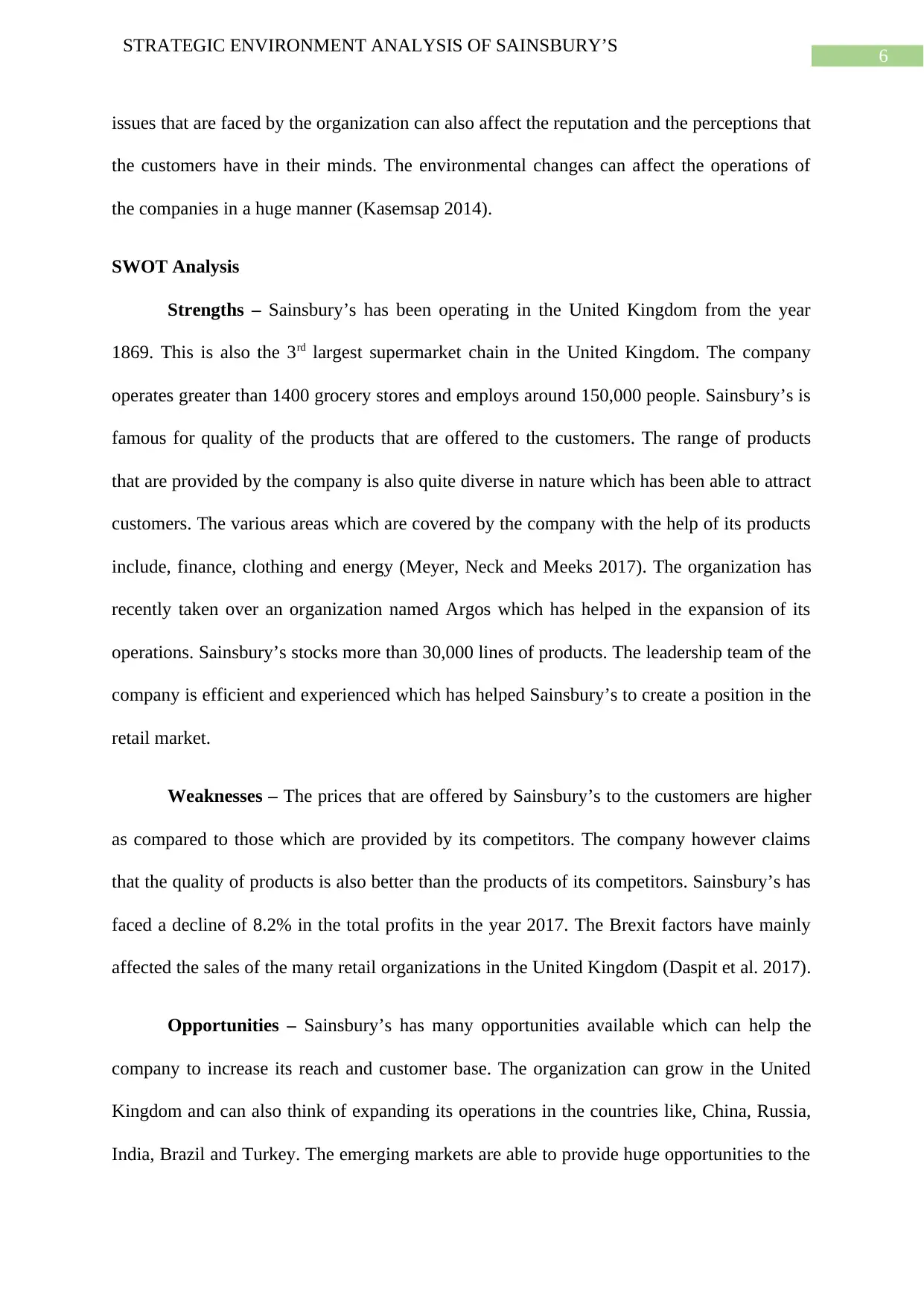
6
STRATEGIC ENVIRONMENT ANALYSIS OF SAINSBURY’S
issues that are faced by the organization can also affect the reputation and the perceptions that
the customers have in their minds. The environmental changes can affect the operations of
the companies in a huge manner (Kasemsap 2014).
SWOT Analysis
Strengths – Sainsbury’s has been operating in the United Kingdom from the year
1869. This is also the 3rd largest supermarket chain in the United Kingdom. The company
operates greater than 1400 grocery stores and employs around 150,000 people. Sainsbury’s is
famous for quality of the products that are offered to the customers. The range of products
that are provided by the company is also quite diverse in nature which has been able to attract
customers. The various areas which are covered by the company with the help of its products
include, finance, clothing and energy (Meyer, Neck and Meeks 2017). The organization has
recently taken over an organization named Argos which has helped in the expansion of its
operations. Sainsbury’s stocks more than 30,000 lines of products. The leadership team of the
company is efficient and experienced which has helped Sainsbury’s to create a position in the
retail market.
Weaknesses – The prices that are offered by Sainsbury’s to the customers are higher
as compared to those which are provided by its competitors. The company however claims
that the quality of products is also better than the products of its competitors. Sainsbury’s has
faced a decline of 8.2% in the total profits in the year 2017. The Brexit factors have mainly
affected the sales of the many retail organizations in the United Kingdom (Daspit et al. 2017).
Opportunities – Sainsbury’s has many opportunities available which can help the
company to increase its reach and customer base. The organization can grow in the United
Kingdom and can also think of expanding its operations in the countries like, China, Russia,
India, Brazil and Turkey. The emerging markets are able to provide huge opportunities to the
STRATEGIC ENVIRONMENT ANALYSIS OF SAINSBURY’S
issues that are faced by the organization can also affect the reputation and the perceptions that
the customers have in their minds. The environmental changes can affect the operations of
the companies in a huge manner (Kasemsap 2014).
SWOT Analysis
Strengths – Sainsbury’s has been operating in the United Kingdom from the year
1869. This is also the 3rd largest supermarket chain in the United Kingdom. The company
operates greater than 1400 grocery stores and employs around 150,000 people. Sainsbury’s is
famous for quality of the products that are offered to the customers. The range of products
that are provided by the company is also quite diverse in nature which has been able to attract
customers. The various areas which are covered by the company with the help of its products
include, finance, clothing and energy (Meyer, Neck and Meeks 2017). The organization has
recently taken over an organization named Argos which has helped in the expansion of its
operations. Sainsbury’s stocks more than 30,000 lines of products. The leadership team of the
company is efficient and experienced which has helped Sainsbury’s to create a position in the
retail market.
Weaknesses – The prices that are offered by Sainsbury’s to the customers are higher
as compared to those which are provided by its competitors. The company however claims
that the quality of products is also better than the products of its competitors. Sainsbury’s has
faced a decline of 8.2% in the total profits in the year 2017. The Brexit factors have mainly
affected the sales of the many retail organizations in the United Kingdom (Daspit et al. 2017).
Opportunities – Sainsbury’s has many opportunities available which can help the
company to increase its reach and customer base. The organization can grow in the United
Kingdom and can also think of expanding its operations in the countries like, China, Russia,
India, Brazil and Turkey. The emerging markets are able to provide huge opportunities to the
Paraphrase This Document
Need a fresh take? Get an instant paraphrase of this document with our AI Paraphraser
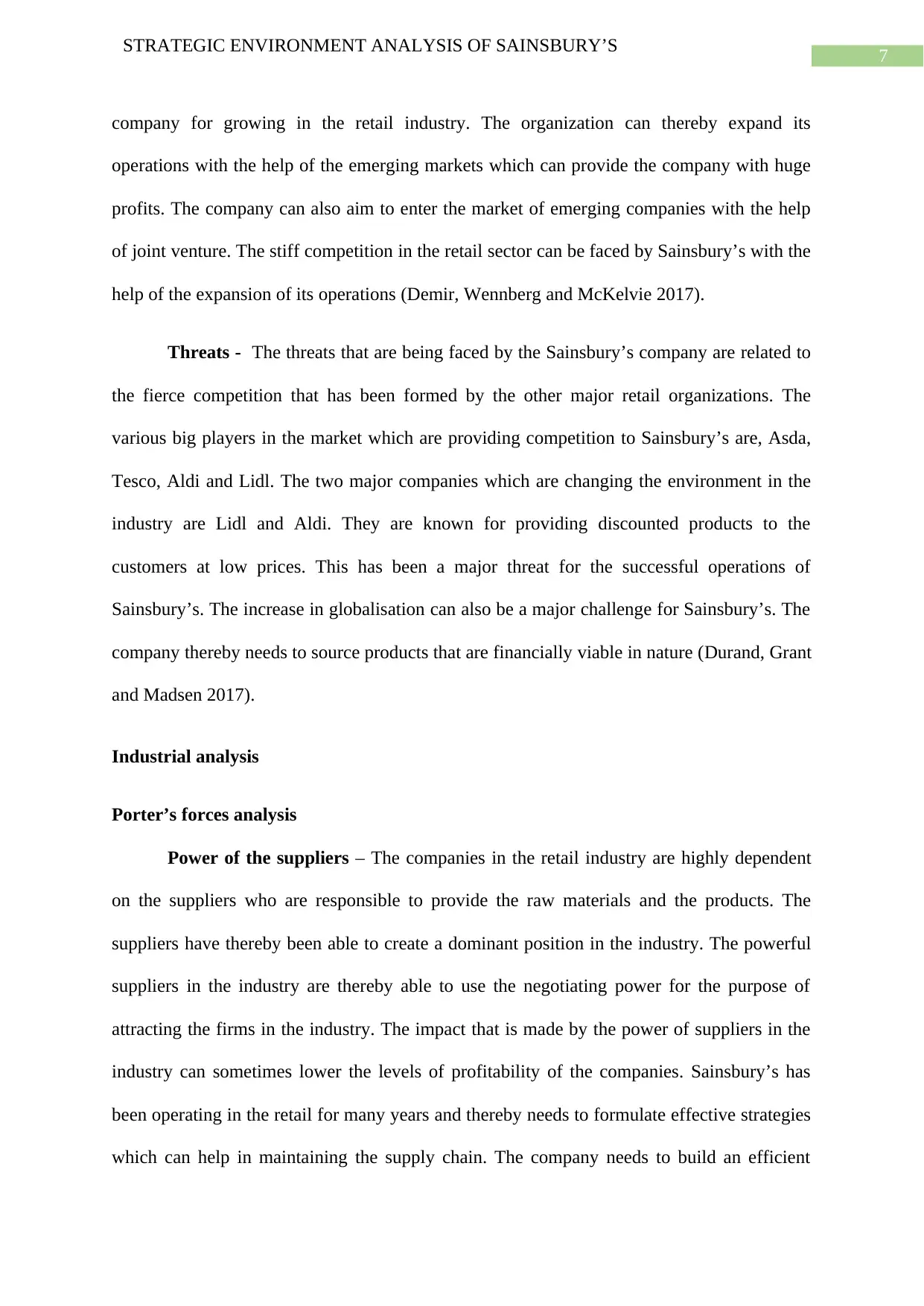
7
STRATEGIC ENVIRONMENT ANALYSIS OF SAINSBURY’S
company for growing in the retail industry. The organization can thereby expand its
operations with the help of the emerging markets which can provide the company with huge
profits. The company can also aim to enter the market of emerging companies with the help
of joint venture. The stiff competition in the retail sector can be faced by Sainsbury’s with the
help of the expansion of its operations (Demir, Wennberg and McKelvie 2017).
Threats - The threats that are being faced by the Sainsbury’s company are related to
the fierce competition that has been formed by the other major retail organizations. The
various big players in the market which are providing competition to Sainsbury’s are, Asda,
Tesco, Aldi and Lidl. The two major companies which are changing the environment in the
industry are Lidl and Aldi. They are known for providing discounted products to the
customers at low prices. This has been a major threat for the successful operations of
Sainsbury’s. The increase in globalisation can also be a major challenge for Sainsbury’s. The
company thereby needs to source products that are financially viable in nature (Durand, Grant
and Madsen 2017).
Industrial analysis
Porter’s forces analysis
Power of the suppliers – The companies in the retail industry are highly dependent
on the suppliers who are responsible to provide the raw materials and the products. The
suppliers have thereby been able to create a dominant position in the industry. The powerful
suppliers in the industry are thereby able to use the negotiating power for the purpose of
attracting the firms in the industry. The impact that is made by the power of suppliers in the
industry can sometimes lower the levels of profitability of the companies. Sainsbury’s has
been operating in the retail for many years and thereby needs to formulate effective strategies
which can help in maintaining the supply chain. The company needs to build an efficient
STRATEGIC ENVIRONMENT ANALYSIS OF SAINSBURY’S
company for growing in the retail industry. The organization can thereby expand its
operations with the help of the emerging markets which can provide the company with huge
profits. The company can also aim to enter the market of emerging companies with the help
of joint venture. The stiff competition in the retail sector can be faced by Sainsbury’s with the
help of the expansion of its operations (Demir, Wennberg and McKelvie 2017).
Threats - The threats that are being faced by the Sainsbury’s company are related to
the fierce competition that has been formed by the other major retail organizations. The
various big players in the market which are providing competition to Sainsbury’s are, Asda,
Tesco, Aldi and Lidl. The two major companies which are changing the environment in the
industry are Lidl and Aldi. They are known for providing discounted products to the
customers at low prices. This has been a major threat for the successful operations of
Sainsbury’s. The increase in globalisation can also be a major challenge for Sainsbury’s. The
company thereby needs to source products that are financially viable in nature (Durand, Grant
and Madsen 2017).
Industrial analysis
Porter’s forces analysis
Power of the suppliers – The companies in the retail industry are highly dependent
on the suppliers who are responsible to provide the raw materials and the products. The
suppliers have thereby been able to create a dominant position in the industry. The powerful
suppliers in the industry are thereby able to use the negotiating power for the purpose of
attracting the firms in the industry. The impact that is made by the power of suppliers in the
industry can sometimes lower the levels of profitability of the companies. Sainsbury’s has
been operating in the retail for many years and thereby needs to formulate effective strategies
which can help in maintaining the supply chain. The company needs to build an efficient
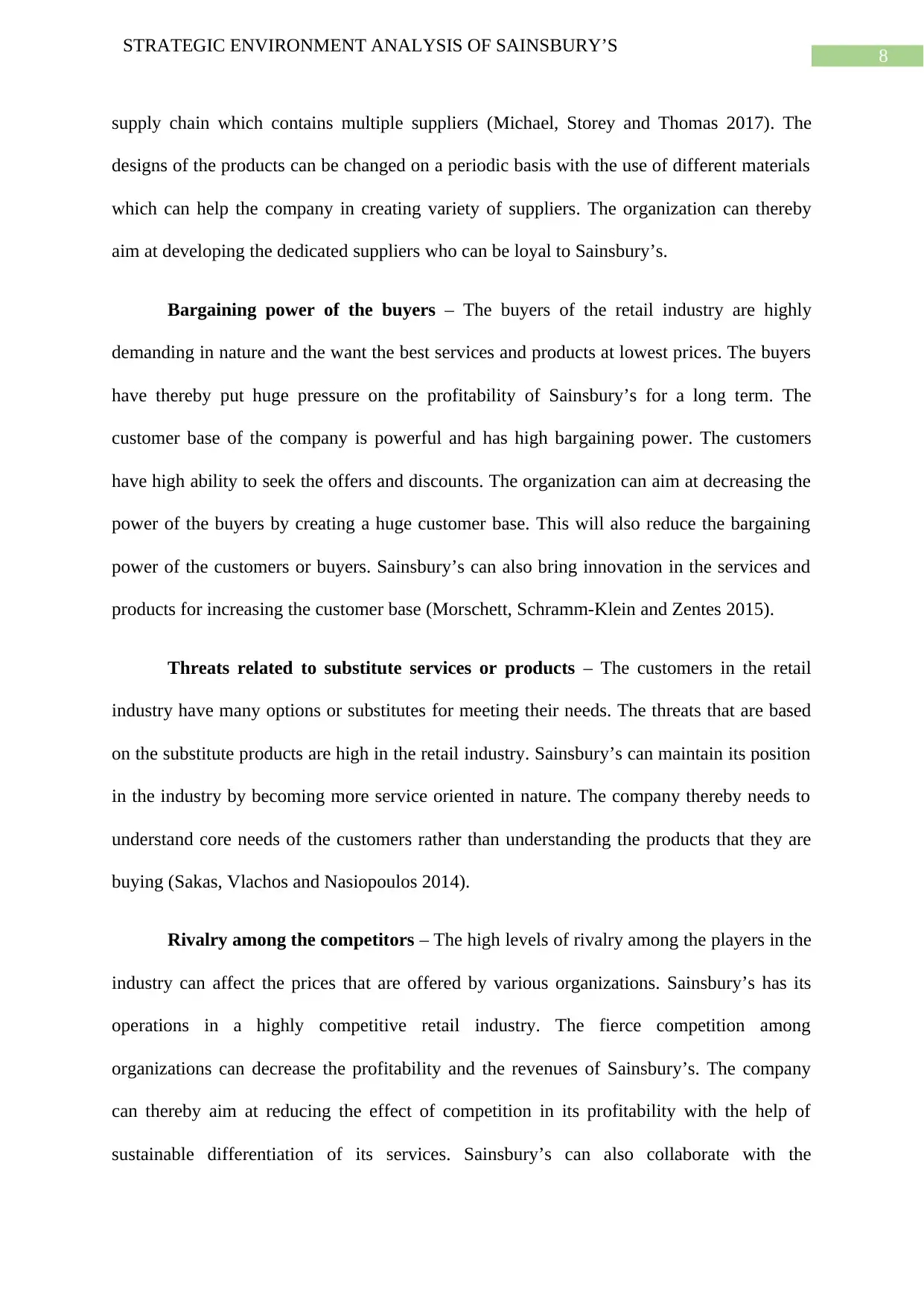
8
STRATEGIC ENVIRONMENT ANALYSIS OF SAINSBURY’S
supply chain which contains multiple suppliers (Michael, Storey and Thomas 2017). The
designs of the products can be changed on a periodic basis with the use of different materials
which can help the company in creating variety of suppliers. The organization can thereby
aim at developing the dedicated suppliers who can be loyal to Sainsbury’s.
Bargaining power of the buyers – The buyers of the retail industry are highly
demanding in nature and the want the best services and products at lowest prices. The buyers
have thereby put huge pressure on the profitability of Sainsbury’s for a long term. The
customer base of the company is powerful and has high bargaining power. The customers
have high ability to seek the offers and discounts. The organization can aim at decreasing the
power of the buyers by creating a huge customer base. This will also reduce the bargaining
power of the customers or buyers. Sainsbury’s can also bring innovation in the services and
products for increasing the customer base (Morschett, Schramm-Klein and Zentes 2015).
Threats related to substitute services or products – The customers in the retail
industry have many options or substitutes for meeting their needs. The threats that are based
on the substitute products are high in the retail industry. Sainsbury’s can maintain its position
in the industry by becoming more service oriented in nature. The company thereby needs to
understand core needs of the customers rather than understanding the products that they are
buying (Sakas, Vlachos and Nasiopoulos 2014).
Rivalry among the competitors – The high levels of rivalry among the players in the
industry can affect the prices that are offered by various organizations. Sainsbury’s has its
operations in a highly competitive retail industry. The fierce competition among
organizations can decrease the profitability and the revenues of Sainsbury’s. The company
can thereby aim at reducing the effect of competition in its profitability with the help of
sustainable differentiation of its services. Sainsbury’s can also collaborate with the
STRATEGIC ENVIRONMENT ANALYSIS OF SAINSBURY’S
supply chain which contains multiple suppliers (Michael, Storey and Thomas 2017). The
designs of the products can be changed on a periodic basis with the use of different materials
which can help the company in creating variety of suppliers. The organization can thereby
aim at developing the dedicated suppliers who can be loyal to Sainsbury’s.
Bargaining power of the buyers – The buyers of the retail industry are highly
demanding in nature and the want the best services and products at lowest prices. The buyers
have thereby put huge pressure on the profitability of Sainsbury’s for a long term. The
customer base of the company is powerful and has high bargaining power. The customers
have high ability to seek the offers and discounts. The organization can aim at decreasing the
power of the buyers by creating a huge customer base. This will also reduce the bargaining
power of the customers or buyers. Sainsbury’s can also bring innovation in the services and
products for increasing the customer base (Morschett, Schramm-Klein and Zentes 2015).
Threats related to substitute services or products – The customers in the retail
industry have many options or substitutes for meeting their needs. The threats that are based
on the substitute products are high in the retail industry. Sainsbury’s can maintain its position
in the industry by becoming more service oriented in nature. The company thereby needs to
understand core needs of the customers rather than understanding the products that they are
buying (Sakas, Vlachos and Nasiopoulos 2014).
Rivalry among the competitors – The high levels of rivalry among the players in the
industry can affect the prices that are offered by various organizations. Sainsbury’s has its
operations in a highly competitive retail industry. The fierce competition among
organizations can decrease the profitability and the revenues of Sainsbury’s. The company
can thereby aim at reducing the effect of competition in its profitability with the help of
sustainable differentiation of its services. Sainsbury’s can also collaborate with the
⊘ This is a preview!⊘
Do you want full access?
Subscribe today to unlock all pages.

Trusted by 1+ million students worldwide
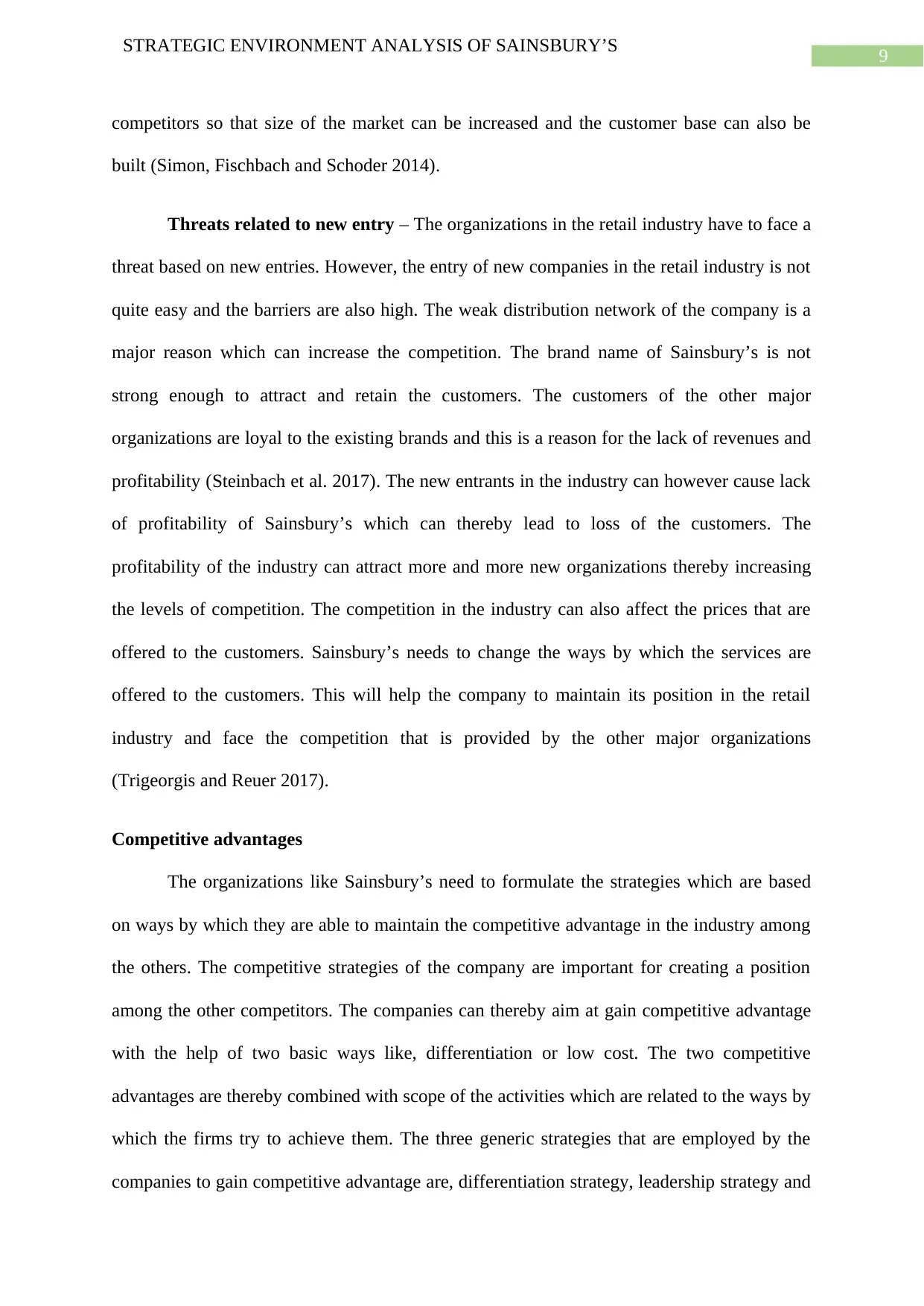
9
STRATEGIC ENVIRONMENT ANALYSIS OF SAINSBURY’S
competitors so that size of the market can be increased and the customer base can also be
built (Simon, Fischbach and Schoder 2014).
Threats related to new entry – The organizations in the retail industry have to face a
threat based on new entries. However, the entry of new companies in the retail industry is not
quite easy and the barriers are also high. The weak distribution network of the company is a
major reason which can increase the competition. The brand name of Sainsbury’s is not
strong enough to attract and retain the customers. The customers of the other major
organizations are loyal to the existing brands and this is a reason for the lack of revenues and
profitability (Steinbach et al. 2017). The new entrants in the industry can however cause lack
of profitability of Sainsbury’s which can thereby lead to loss of the customers. The
profitability of the industry can attract more and more new organizations thereby increasing
the levels of competition. The competition in the industry can also affect the prices that are
offered to the customers. Sainsbury’s needs to change the ways by which the services are
offered to the customers. This will help the company to maintain its position in the retail
industry and face the competition that is provided by the other major organizations
(Trigeorgis and Reuer 2017).
Competitive advantages
The organizations like Sainsbury’s need to formulate the strategies which are based
on ways by which they are able to maintain the competitive advantage in the industry among
the others. The competitive strategies of the company are important for creating a position
among the other competitors. The companies can thereby aim at gain competitive advantage
with the help of two basic ways like, differentiation or low cost. The two competitive
advantages are thereby combined with scope of the activities which are related to the ways by
which the firms try to achieve them. The three generic strategies that are employed by the
companies to gain competitive advantage are, differentiation strategy, leadership strategy and
STRATEGIC ENVIRONMENT ANALYSIS OF SAINSBURY’S
competitors so that size of the market can be increased and the customer base can also be
built (Simon, Fischbach and Schoder 2014).
Threats related to new entry – The organizations in the retail industry have to face a
threat based on new entries. However, the entry of new companies in the retail industry is not
quite easy and the barriers are also high. The weak distribution network of the company is a
major reason which can increase the competition. The brand name of Sainsbury’s is not
strong enough to attract and retain the customers. The customers of the other major
organizations are loyal to the existing brands and this is a reason for the lack of revenues and
profitability (Steinbach et al. 2017). The new entrants in the industry can however cause lack
of profitability of Sainsbury’s which can thereby lead to loss of the customers. The
profitability of the industry can attract more and more new organizations thereby increasing
the levels of competition. The competition in the industry can also affect the prices that are
offered to the customers. Sainsbury’s needs to change the ways by which the services are
offered to the customers. This will help the company to maintain its position in the retail
industry and face the competition that is provided by the other major organizations
(Trigeorgis and Reuer 2017).
Competitive advantages
The organizations like Sainsbury’s need to formulate the strategies which are based
on ways by which they are able to maintain the competitive advantage in the industry among
the others. The competitive strategies of the company are important for creating a position
among the other competitors. The companies can thereby aim at gain competitive advantage
with the help of two basic ways like, differentiation or low cost. The two competitive
advantages are thereby combined with scope of the activities which are related to the ways by
which the firms try to achieve them. The three generic strategies that are employed by the
companies to gain competitive advantage are, differentiation strategy, leadership strategy and
Paraphrase This Document
Need a fresh take? Get an instant paraphrase of this document with our AI Paraphraser
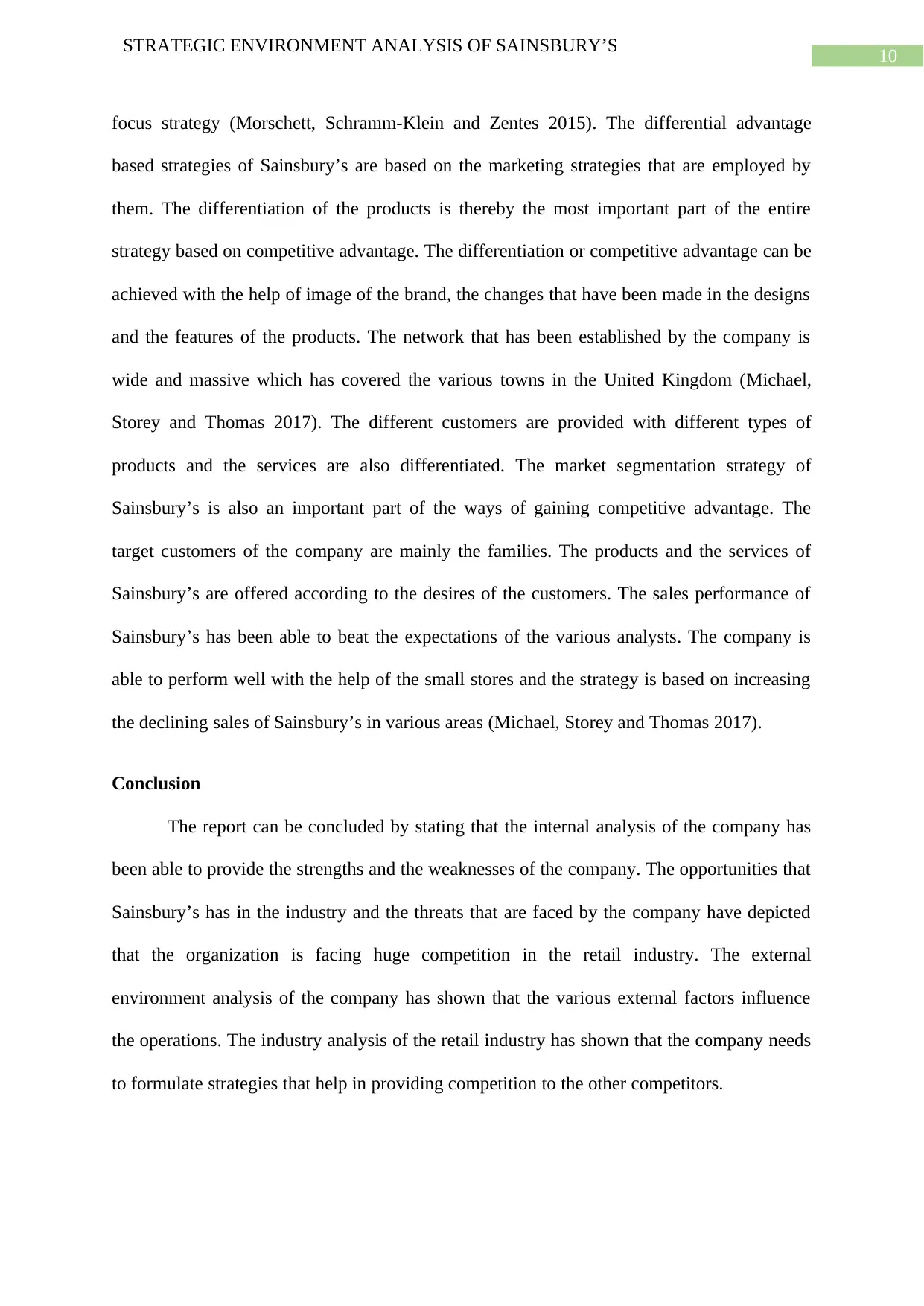
10
STRATEGIC ENVIRONMENT ANALYSIS OF SAINSBURY’S
focus strategy (Morschett, Schramm-Klein and Zentes 2015). The differential advantage
based strategies of Sainsbury’s are based on the marketing strategies that are employed by
them. The differentiation of the products is thereby the most important part of the entire
strategy based on competitive advantage. The differentiation or competitive advantage can be
achieved with the help of image of the brand, the changes that have been made in the designs
and the features of the products. The network that has been established by the company is
wide and massive which has covered the various towns in the United Kingdom (Michael,
Storey and Thomas 2017). The different customers are provided with different types of
products and the services are also differentiated. The market segmentation strategy of
Sainsbury’s is also an important part of the ways of gaining competitive advantage. The
target customers of the company are mainly the families. The products and the services of
Sainsbury’s are offered according to the desires of the customers. The sales performance of
Sainsbury’s has been able to beat the expectations of the various analysts. The company is
able to perform well with the help of the small stores and the strategy is based on increasing
the declining sales of Sainsbury’s in various areas (Michael, Storey and Thomas 2017).
Conclusion
The report can be concluded by stating that the internal analysis of the company has
been able to provide the strengths and the weaknesses of the company. The opportunities that
Sainsbury’s has in the industry and the threats that are faced by the company have depicted
that the organization is facing huge competition in the retail industry. The external
environment analysis of the company has shown that the various external factors influence
the operations. The industry analysis of the retail industry has shown that the company needs
to formulate strategies that help in providing competition to the other competitors.
STRATEGIC ENVIRONMENT ANALYSIS OF SAINSBURY’S
focus strategy (Morschett, Schramm-Klein and Zentes 2015). The differential advantage
based strategies of Sainsbury’s are based on the marketing strategies that are employed by
them. The differentiation of the products is thereby the most important part of the entire
strategy based on competitive advantage. The differentiation or competitive advantage can be
achieved with the help of image of the brand, the changes that have been made in the designs
and the features of the products. The network that has been established by the company is
wide and massive which has covered the various towns in the United Kingdom (Michael,
Storey and Thomas 2017). The different customers are provided with different types of
products and the services are also differentiated. The market segmentation strategy of
Sainsbury’s is also an important part of the ways of gaining competitive advantage. The
target customers of the company are mainly the families. The products and the services of
Sainsbury’s are offered according to the desires of the customers. The sales performance of
Sainsbury’s has been able to beat the expectations of the various analysts. The company is
able to perform well with the help of the small stores and the strategy is based on increasing
the declining sales of Sainsbury’s in various areas (Michael, Storey and Thomas 2017).
Conclusion
The report can be concluded by stating that the internal analysis of the company has
been able to provide the strengths and the weaknesses of the company. The opportunities that
Sainsbury’s has in the industry and the threats that are faced by the company have depicted
that the organization is facing huge competition in the retail industry. The external
environment analysis of the company has shown that the various external factors influence
the operations. The industry analysis of the retail industry has shown that the company needs
to formulate strategies that help in providing competition to the other competitors.
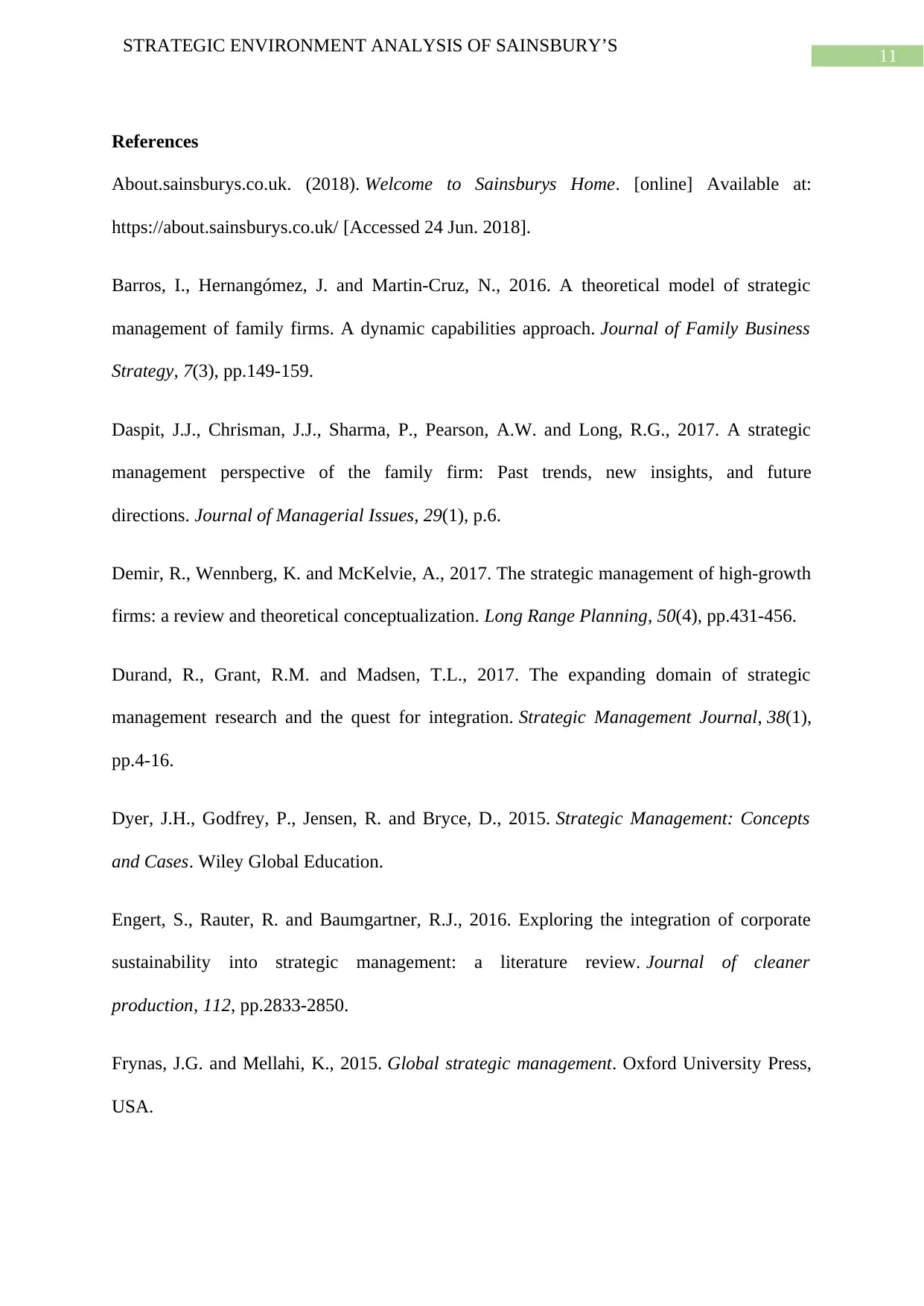
11
STRATEGIC ENVIRONMENT ANALYSIS OF SAINSBURY’S
References
About.sainsburys.co.uk. (2018). Welcome to Sainsburys Home. [online] Available at:
https://about.sainsburys.co.uk/ [Accessed 24 Jun. 2018].
Barros, I., Hernangómez, J. and Martin-Cruz, N., 2016. A theoretical model of strategic
management of family firms. A dynamic capabilities approach. Journal of Family Business
Strategy, 7(3), pp.149-159.
Daspit, J.J., Chrisman, J.J., Sharma, P., Pearson, A.W. and Long, R.G., 2017. A strategic
management perspective of the family firm: Past trends, new insights, and future
directions. Journal of Managerial Issues, 29(1), p.6.
Demir, R., Wennberg, K. and McKelvie, A., 2017. The strategic management of high-growth
firms: a review and theoretical conceptualization. Long Range Planning, 50(4), pp.431-456.
Durand, R., Grant, R.M. and Madsen, T.L., 2017. The expanding domain of strategic
management research and the quest for integration. Strategic Management Journal, 38(1),
pp.4-16.
Dyer, J.H., Godfrey, P., Jensen, R. and Bryce, D., 2015. Strategic Management: Concepts
and Cases. Wiley Global Education.
Engert, S., Rauter, R. and Baumgartner, R.J., 2016. Exploring the integration of corporate
sustainability into strategic management: a literature review. Journal of cleaner
production, 112, pp.2833-2850.
Frynas, J.G. and Mellahi, K., 2015. Global strategic management. Oxford University Press,
USA.
STRATEGIC ENVIRONMENT ANALYSIS OF SAINSBURY’S
References
About.sainsburys.co.uk. (2018). Welcome to Sainsburys Home. [online] Available at:
https://about.sainsburys.co.uk/ [Accessed 24 Jun. 2018].
Barros, I., Hernangómez, J. and Martin-Cruz, N., 2016. A theoretical model of strategic
management of family firms. A dynamic capabilities approach. Journal of Family Business
Strategy, 7(3), pp.149-159.
Daspit, J.J., Chrisman, J.J., Sharma, P., Pearson, A.W. and Long, R.G., 2017. A strategic
management perspective of the family firm: Past trends, new insights, and future
directions. Journal of Managerial Issues, 29(1), p.6.
Demir, R., Wennberg, K. and McKelvie, A., 2017. The strategic management of high-growth
firms: a review and theoretical conceptualization. Long Range Planning, 50(4), pp.431-456.
Durand, R., Grant, R.M. and Madsen, T.L., 2017. The expanding domain of strategic
management research and the quest for integration. Strategic Management Journal, 38(1),
pp.4-16.
Dyer, J.H., Godfrey, P., Jensen, R. and Bryce, D., 2015. Strategic Management: Concepts
and Cases. Wiley Global Education.
Engert, S., Rauter, R. and Baumgartner, R.J., 2016. Exploring the integration of corporate
sustainability into strategic management: a literature review. Journal of cleaner
production, 112, pp.2833-2850.
Frynas, J.G. and Mellahi, K., 2015. Global strategic management. Oxford University Press,
USA.
⊘ This is a preview!⊘
Do you want full access?
Subscribe today to unlock all pages.

Trusted by 1+ million students worldwide
1 out of 14
Related Documents
Your All-in-One AI-Powered Toolkit for Academic Success.
+13062052269
info@desklib.com
Available 24*7 on WhatsApp / Email
![[object Object]](/_next/static/media/star-bottom.7253800d.svg)
Unlock your academic potential
Copyright © 2020–2025 A2Z Services. All Rights Reserved. Developed and managed by ZUCOL.





